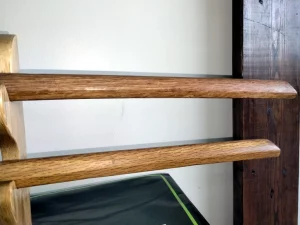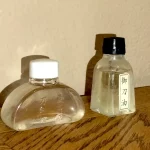 Bokken and iaito maintenance are essential elements of training in Japanese Sword Arts. Without attention to these details, your iaito may become rusty and less smooth to draw, and your bokken may become splintered and cause injury to yourself and other students.
Bokken and iaito maintenance are essential elements of training in Japanese Sword Arts. Without attention to these details, your iaito may become rusty and less smooth to draw, and your bokken may become splintered and cause injury to yourself and other students.
While I am not an expert in these fields, over the years, I have come to some budget-friendly and reasonably traditional solutions. This article is intended to be a guide to buying, mixing, and using your own oils for maintenance of wooden bokken and steel iaito.
Bokken Maintenance
Some may say that oiling one’s bokken is unnecessary, that the oils imparted into the wood by hands and time are sufficient. Perhaps for some styles of low- or no-contact practice, or for high-quality, old, or pre-oiled bokkens, this is true. The art that I study has sword-to-sword contact in the kata, and beginners sometimes come in with unseasoned bokken and the idea that hitting harder is better. Thus, over time, repeated impacts in the same general areas will cause wood fibers to separate and splinter. I have found that this is a problem that can be somewhat mitigated by proper oiling.
You essentially need only one oil for bokken maintenance, and that is Boiled Linseed Oil. Others can be used, but BLO is relatively cheap and widely available. Prepare a mixture at a 1:1 ratio with a thinning agent such as Mineral Spirits, Citrus Solvent, or Turpentine.
Bokken Oil: 1 part Boiled Linseed Oil 1 part Mineral Spirits
Other Oil Options
Given that the issue with bokkens is delamination and splintering, we need an oil that prevents this. Linseed is a “drying oil” that cures into a flexible polymer and creates a protective finish when applied to wood. We thin the linseed oil to allow it to penetrate the wood fibers more deeply, where it can reinforce them once cured.
An alternative to linseed oil is real, pure Tung Oil. It serves the same essential function as linseed oil, with a few differences. First, linseed oil will cause wood to noticeably yellow with application and time; tung oil’s color change is less pronounced, thus preserving the original beauty of the wood. Tung oil will also tend to cure harder – whether or not this is a good thing for bokkens, I have not yet decided. Finally, real tung oil is generally more expensive. However, pure tung oil thinned with citrus solvent can also serve as a food-safe finish for your cutting boards and kitchen utensils.
I highly recommend against using varnish, polyurethane, lacquer, and many kinds of paint. The reason is that they tend to create a superficial and/or brittle finish that does not reinforce the fibers of the wood from impacts. Be careful when browsing the options at the hardware store; some products, such as Minwax Tung Oil Finish, are not actually tung oil, but rather a varnish that is intended to imitate the look of a well-polished tung oil finish.
I would also recommend against using “non-drying” oils, such as cooking oils, waxes, or petroleum-based oils, as they will not reinforce the wood fibers, and some might actually weaken them. Cooking oils may also go rancid. Linseed oil, in its raw form, cures so slowly that I similarly do not recommend it. Use the “boiled” form (which is usually not actually boiled, but for our purposes, that is a distinction without a difference).
Oiling a Bokken for the First Time
- Check the bokken for damage. If it already has severe damage, you may need to repair it first (article forthcoming).
- Sand the bokken smooth.1,2,3 I like to finish with 250-grit sandpaper before oiling. It is also a good idea to slightly round any sharp angles along the spine, as these encourage splinters.
- Apply oil everywhere on the bokken. Use a rag, dab the oil onto it, and then wipe oil onto the wood.4
- Wait 10-15 minutes. You might find that some or all of the oil has soaked into the wood and left dry areas. Apply more oil to the dry areas. Repeat this step up to two more times.
- Wipe away any excess oil and allow 24 hours to cure.
- Give the bokken a very light sanding to take down any fibers that may have been raised. If you see dry areas, repeat from step 3.5
- The bokken should feel smooth, woody, and waxy, without feeling tacky at all. If it does feel tacky, this means that there is excess oil on the surface. Use a rag to rub it away.
- If you prefer a less waxy texture, lightly sand with 500 up to 1000 grit sandpaper.
- Many bokkens come with a wax or varnish coating to protect them from moisture during storage and transport. This will need to be sanded off, to allow our oil through.
- Many “white oak” bokkens have been bleached to resemble Japanese white oak. You may consider sanding through the bleached surface layer to reveal the natural color of the wood, in accordance with your own aesthetic preferences.
- It is better to sand with the grain to avoid visible scratches.
- One technique you may try is to rub the oil in using 500-grit sandpaper. The idea behind this is that the sandpaper will wet-polish the wood while adding some sawdust into the oil, which will act as an aggregate for filling pores. If you do this, you may skip the sanding in step 6.
- You may optionally use progressively less-diluted solutions of oil. Start it off thin to soak into the wood fibers and finish with an undiluted solution for the toughest cure.
Maintaining a Bokken
Once you have your base of oil as described in the previous section, your bokken should require very little maintenance. Apply a thin coat of oil every month or so, and give it a bit of sanding if you feel any roughness.
You will only need to do more than this if your bokken develops a splinter. I intend to write a separate guide on how to repair a damaged bokken. Forthcoming.
Iaito Maintenance
The purpose and process of iaito maintenance are well-known and taught to most every student, so I need not elaborate here. This section will be limited to oil choice.
The easiest option is to buy Choji Oil from a store. This is also often the most expensive option, and the price is unjustified, in my opinion. The reason I feel this way is that choji oil is so easy and cheap to make.
To make your own Choji oil, simply mix one part Clove Essential Oil with 100 parts Mineral Oil. At the time of this writing, a 474ml (16 fl oz) bottle of mineral oil (sold as a laxative) costs $2.08 at Walmart. Add 5ml of clove oil to this, shake it up, and you now have a lifetime supply of choji oil for under $10.
Choji Oil: 1 part Clove Essential Oil 100 parts Mineral Oil
Other Oil Options
Choji oil is the traditional choice for iaito maintenance. Although it is not the best option for long-term rust protection, it is one of the best for an active iaido practitioner because the sword spends much of its time inside the saya, which is made of wood. Any oil that comes into contact with this wood should do minimal damage to it. Choji oil is non-toxic, will not go rancid, thicken over time, or impart any odor onto the saya except for that of clove. Regular re-application eliminates its drawback.
Alternatively, you could use straight mineral oil. The clove oil is mostly there for scent, although some say it also serves as an antimicrobial and antifungal agent. You can add as much or as little clove oil as you like, or none at all, depending on your preferences. You could even use different scented oils. Another advantage of a mineral oil base is that, being available in food-safe grades, you can use it to protect metal kitchen utensils such as carbon steel knives.
That said, some martial artists will go a less traditional route, and use a machine oil. 3-in-one oil is versatile and will protect steel from rust. But it may not be great for the wooden saya, and will impart a chemical smell on the wood and on the sword. While storing a sword on display outside of the saya, I have found M-Pro 7 LPX gun oil to provide effective and long-lasting rust protection.
I would not recommend WD-40 or Rem Oil for either practice or for storage. For practice, they smell, and from my observations, they loosen wood fibers. For storage, they are runny and tend to leave bare spots that will rust.
I would not recommend any plant- or animal-based oils, such as cooking oil, wood oil, or tallow, which would go rancid and/or gum up over time. Any of these that are transferred from the sword into the saya will be similarly troublesome.


